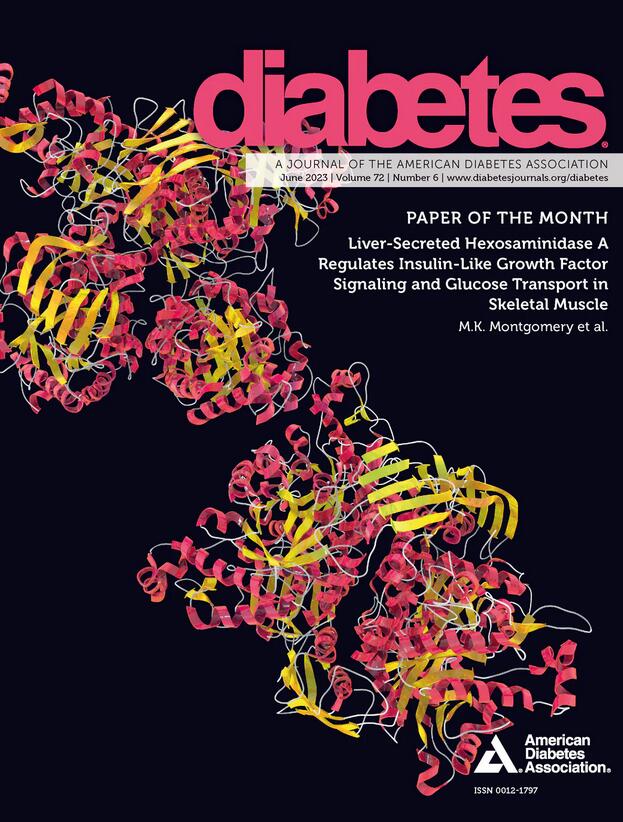2182-LB: Development and Characterization of a Humanized GLP-1 Receptor Mouse Model for the Evaluation of Small-Molecule GLP1R Agonists
IF 7.5
1区 医学
Q1 ENDOCRINOLOGY & METABOLISM
引用次数: 0
Abstract
Introduction and Objective: Injectable peptide-based GLP-1 receptor agonists (GLP1RAs) have emerged as effective therapies for obesity and diabetes. However, peptide-based GLP1RAs present challenges related to patient compliance and scalable production. Small-molecule GLP1RAs offer advantages in oral administration but exhibit poor activity on rodent GLP1R, complicating preclinical pharmacodynamic assessments. To improve translational relevance, we developed a humanized GLP1R (hGLP1R) mouse model using CRISPR-Cas9 gene editing, replacing the endogenous murine receptor with the human form. Methods: The hGLP1R mouse model was generated by replacing the murine GLP1R with the human GLP1R using CRISPR-Cas9 gene editing. Immunohistochemical analyses confirmed hGLP1R expression in pancreatic beta cells, brain stem, and hypothalamus. Pharmacological characterization included single-dose and chronic treatment studies evaluating the metabolic effects of semaglutide (peptide GLP1RA) and orforglipron (small-molecule GLP1RA) in both lean and DIO hGLP1R and wt mice. Additionally, 3D whole-brain imaging was performed to assess central target engagement. Results: Single-dose studies in lean hGLP1R mice showed comparable efficacy of semaglutide and orforglipron on body weight, food intake, glucose tolerance, and conditioned taste aversion. Semaglutide, but not orforglipron, also demonstrated metabolic effects in lean wt mice. Chronic semaglutide and orforglipron treatment significantly reduced body weight, whole-body fat mass, and food intake in DIO hGLP1R mice, with no effect of orforglipron observed in DIO wild-type mice. 3D whole-brain imaging confirmed activation of canonical appetite-regulating brain regions by both semaglutide and orforglipron in hGLP1R mice. Conclusion: These findings validate the Gubra hGLP1R mouse as a relevant preclinical model to advance preclinical development of small-molecule GLP1RAs for the treatment of obesity and related metabolic disorders. Disclosure N. Sonne: None. K. Abney: Research Support; TERNS Pharmaceuticals. M. Feigh: None. H.H. Hansen: None. C. Jones: Employee; TERNS Pharmaceuticals. O. Osborn: None. M.L. Riis: None. S.E. Pors: None. M. Cavalera: None. L.F. Zachariassen: None. M. Tozzi: None.2182-LB:用于评估小分子GLP1R激动剂的人源化GLP-1受体小鼠模型的建立和表征
简介和目的:可注射肽基GLP-1受体激动剂(GLP1RAs)已成为肥胖和糖尿病的有效治疗方法。然而,基于肽的GLP1RAs存在与患者依从性和可扩展生产相关的挑战。小分子GLP1RAs在口服给药方面具有优势,但对啮齿动物GLP1R的活性较差,使临床前药效学评估复杂化。为了提高翻译相关性,我们使用CRISPR-Cas9基因编辑技术开发了人源化GLP1R (hGLP1R)小鼠模型,用人形式替代内源性小鼠受体。方法:采用CRISPR-Cas9基因编辑技术,将小鼠GLP1R替换为人类GLP1R,构建hGLP1R小鼠模型。免疫组织化学分析证实hGLP1R在胰腺β细胞、脑干和下丘脑中表达。药理学表征包括单剂量和慢性治疗研究,评估了semaglutide(肽GLP1RA)和orforglipron(小分子GLP1RA)在lean和DIO hGLP1R和wt小鼠中的代谢作用。此外,进行3D全脑成像以评估中枢靶标接合情况。结果:在瘦型hGLP1R小鼠中进行的单剂量研究显示,semaglutide和orforglipron对体重、食物摄入、葡萄糖耐量和条件性味觉厌恶的疗效相当。Semaglutide,而不是orforglipron,在瘦体重小鼠中也显示出代谢作用。慢性semaglutide和orforglipron治疗显著降低DIO hGLP1R小鼠的体重、全身脂肪量和食物摄入量,而在DIO野生型小鼠中没有观察到orforglipron的影响。3D全脑成像证实,在hGLP1R小鼠中,semaglutide和orforglipron激活了典型的食欲调节脑区。结论:这些发现验证了Gubra hGLP1R小鼠作为一种相关的临床前模型,可以推进小分子GLP1RAs治疗肥胖及相关代谢紊乱的临床前开发。索恩:没有。K. Abney:研究支持;燕鸥药品。菲格:没有。汉森:没有。琼斯:雇员;燕鸥药品。奥斯本:没有。M.L.里斯:没有。S.E. Pors:没有。卡瓦拉先生:没有。L.F. Zachariassen:没有。托齐:没有。
本文章由计算机程序翻译,如有差异,请以英文原文为准。
求助全文
约1分钟内获得全文
求助全文
来源期刊

Diabetes
医学-内分泌学与代谢
CiteScore
12.50
自引率
2.60%
发文量
1968
审稿时长
1 months
期刊介绍:
Diabetes is a scientific journal that publishes original research exploring the physiological and pathophysiological aspects of diabetes mellitus. We encourage submissions of manuscripts pertaining to laboratory, animal, or human research, covering a wide range of topics. Our primary focus is on investigative reports investigating various aspects such as the development and progression of diabetes, along with its associated complications. We also welcome studies delving into normal and pathological pancreatic islet function and intermediary metabolism, as well as exploring the mechanisms of drug and hormone action from a pharmacological perspective. Additionally, we encourage submissions that delve into the biochemical and molecular aspects of both normal and abnormal biological processes.
However, it is important to note that we do not publish studies relating to diabetes education or the application of accepted therapeutic and diagnostic approaches to patients with diabetes mellitus. Our aim is to provide a platform for research that contributes to advancing our understanding of the underlying mechanisms and processes of diabetes.
 求助内容:
求助内容: 应助结果提醒方式:
应助结果提醒方式:


